Here’s an awesome photo of a Fall Southeastern Dusk-Singing Cicada by Riley Campbell:
Click for a bigger image.
More information about Megatibicen figuratus (Walker, 1858) aka Fall Southeastern Dusk-singing Cicada.
Here’s an awesome photo of a Fall Southeastern Dusk-Singing Cicada by Riley Campbell:
Click for a bigger image.
More information about Megatibicen figuratus (Walker, 1858) aka Fall Southeastern Dusk-singing Cicada.
Davis provided a key of cicadas that belong to the then genus Tibicen in his 1918 article Mississippi Cicadas, with a Key to the Species of the Southeastern United States from volume 26 of the Journal of The New York Entomological Society. Download it from archive.org. This guide works for the Northeast and Midwest as well.
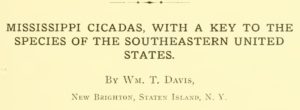
Since 1918, genus and some species names have changed, so I’m going to present the key here, with highlighted notes on the updated names + images (when I have them). I’ll try to replicate the formatting of the original document as best I can.
Here goes…
Note: the cicadas in the key are now organized in three genera: Neotibicen (A B), Megatibicen (A BB), and Diceroprocta (AA).
A. Large, heavy-bodied species; head broad, uncus [male genitals] simple, and first cross vein in the fore wings starting from radius 3 far back or about one-third distant from base of the first marginal cell.
B. Uncus longer than broad. Black species with green or greenish markings and black area on the central part of the abdomen beneath, except in sayi [sayi = Neotibicen tibicen tibicen], and new variety of davisi [new variety of davisi = Neotibicen davisi harnedi].
Note: this group of cicadas (B) are now organized under the genus Neotibicen, not Tibicen.
C. Hind margin of pronotum or collar, green or greenish.
A narrow irregular area of black on the under side of the abdomen; opercula short and broad, and usually in the males an attenuated, pruinose [frosty white] stripe each side on the dorsum of segment three … pruinosa (Say). [pruinosa = Neotibicen pruinosus pruinosus].
Dorsum of abdomen with the hind margin of the segments more or less brown and generally but a trace of pruinose stripe each side on segment three … pruinosa var. winnemanna (Davis) [pruinosa var. winnemanna = Neotibicen winnemanna].
[Generally speaking, east of the Appalachian mountains, you’ll find Neotibicen winnemanna, and west, it’s Neotibicen pruinosus.]
Dorsum of abdomen shining black with a broad pruinose mark each side on segment three; blackened area on under side of abdomen more in the nature of an even stripe … pruinosa var latifasciata (Davis) [pruinosa var. latifasciata = Neotibicen latifasciatus].
A longitudinal band of black on the under side of the abdomen, the opercula more lobate, and the margin of the front wings suddenly bent near the middle … linnei (Smith & Grossbeck) [linnei = Neotibicen linnei].
A definite longitudinal band of black on the under side of the abdomen; head with the front rather prominent. Not a large species … canicularis (Harris) [canicularis = Neotibicen canicularis].
An irregular band of black on the under side of the abdomen, head rounded in front; a rather small species … davisi (Smith & Grossbeck) [davisi = Neotibicen davisi davisi].
Abdomen greenish centrally on under side, blackened area wanting, marginal cells of fore wings clouded … davisi var. harnedi new variety [davisi var. harnedi = Neotibicen davisi harnedi].
CC. Hind margin of pronotum or collar black or nearly so (except in sayi var. australis).
D. Central area of the abdomen beneath black.
Opercula long and with the legs usually somewhat chest- nut colored ; the uncus when seen in profile forked, resembling the open mouth of a snake … similaris (Smith & Grossbeck) [similaris = Neotibicen similaris similaris].
Opercula much shorter, more rounded, and the black area on the under side of the abdomen in the nature of an even stripe. Uncus not forked … lyricen (De Geer) [lyricen = Neotibicen lyricen lyricen].
Blacker than typical lyricen, lacking the considerable amount of fulvous markings on the pronotum and mesonotum. A fulvous somewhat anchor-shaped mark centrally on the pronotum … lyricen var. engelhardti (Davis) [lyricen var. engelhardti = Neotibicen lyricen engelhardti].
DD. Central area of the abdomen not black beneath, often pruinose, as well as the long opercula.
Collar black, often with a greenish spot each side near the outer angles. … sayi (Smith & Grossbeck) [sayi = Neotibicen tibicen tibicen].
Collar all green or nearly so, as well as the pronotum and mesonotum … sayi var. australis (Davis) [sayi = Neotibicen tibicen australis].
BB. The uncus is broad at the base, triangular in shape, and generally about as broad as long. Opercula broad and rounded at the extremities no definite black area on the central part of the abdomen beneath, usually unicolorus.
Note: this group of cicadas (BB) are now organized under the genus Megatibicen, not Tibicen.
E. Wings long and narrow, collar 2 mm. or less in breadth at central portions ; dorsum of abdomen black or nearly so.
Basal cell of fore wings rusty in color, anal cells (membranes) of both pair of wings gray; usually expands 110 mm. or more … resonans (Walker) [resonans = Megatibicen resonans].
Basal cell of fore wings often black or nearly so, anal cells of both pair of wings yellowish. Expands about 100 mm … figurata (Walker) [figurata = Megatibicen figuratus].
EE. Wings broad, hind margin of the pronotum or collar green or greenish and more than 2 mm. broad.
F. Anal cells or membranes at base of fore and hind wings gray.
Dorsal segments of the abdomen not margined with brown ; in fresh specimens the basal segments pruinose, also the terminal segments, leaving the four middle segments black. A large species expanding over 110 mm. … grossus (Fabricius) [grossus = Megatibicen grossus].
FF. Anal cells or membranes at base of fore and hind wings light orange, two prominent marks on the mesonotum resembling the Hebrew letter resh inverted.
Fore wings with the first and second cross veins clouded, and the dorsum of the abdomen brownish or brownish black … resh (Haldeman) [resh = Megatibicen resh].
Fore wings with the first and second cross veins but faintly or not at all clouded and the abdominal segments margined posteriorly with brown. In fresh specimens there is usually a median row of white spots on the dorsum of the abdomen … marginalis (Walker) [marginalis = Megatibicen pronotalis walkeri].
AA. Small species; wings starting from about the middle of the first marginal cell.
Note: this group of cicadas (AA) are now organized under the genus Diceroprocta, not Tibicen.
G. First and second cross veins of fore wings clouded.
Expanse of wings about 90 mm … biconica (Walker) [biconica = Diceroprocta biconica].
Expanse of wings about 60 mm … olympusa (Walker) [olympusa = Diceroprocta olympusa].
GG. First and second cross veins of fore wings not clouded, wings clear throughout and expanding about 70 mm.
Head rather large, front rounded, collar greenish or yellowish and contrasted in color rather sharply with the brown and black of pronotum and mesonotum … viridifascia (Walker) [viridifascia = Diceroprocta viridifascia].
Head proportionately smaller than in the last ; front more pro- truding;- collar not so contrastingly colored and fore wings narrower … vitripennis (Say) [vitripennis = Diceroprocta vitripennis].
and that’s all folks…
Megatibicen figuratus (Walker, 1858) aka Fall Southeastern Dusk-singing Cicada.
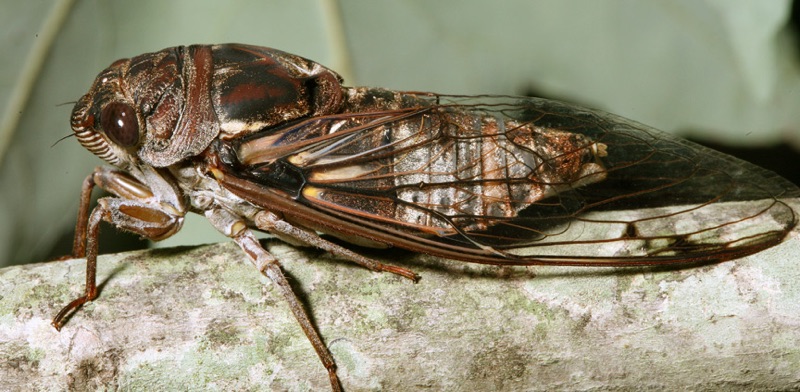
Photo by Paul by Paul Krombholz.
See all Megatibicen figuratus images and information on cicadamania.com.
Source: ©Insect Singers | Species: M. figuratus.
Playlists contain multiple videos found on YouTube.
Cicada figurata Walker.
This species was described [by Walker] in 1858 in List of the Specimens of Homopterous Insects in the collection of the British Museum, Supplement, p. 19. Unfortunately no locality was given. The description in part is as follows: ” Black, mostly tawny beneath. Head with a large tawny spot on each side in front between the eyes. . . . Pro- thorax reddish, black in front and behind, with a double tawny stripe; border tawny, with a black streak on each side. Mesothorax with four oblique tawny stripes; the middle pair recurved inward; the lateral pair enclosed at each of their tips by a lateral tawny streak; sides and hind ridges tawny. Legs tawny. Wings vitreous. Fore wings narrow, much acuminated testaceous at the base, and with a testaceous streak along the sixth discoidal areolet ; primitive areolet black; veins piceous; costa testaceous to the tip of the front areolet; first and second transverse veins slightly curved, clouded with black.
A. Large, heavy bodied species ; head broad, uncus simple, and first cross vein in the fore wings starting from radius 3 far back, or about one third distant from base of first marginal cell.
BB. Uncus broad at the base, triangular in shape and generally about as broad as long. Opercula broad and rounded at the extremities; no definite black area on the central part of the abdomen beneath, usually unicolorus.
E. Wings long and narrow, collar 2 mm. or less in breadth at central portions; dorsum of abdomen black or nearly so.
Basal cell of fore wings often black or nearly so, anal cells of both pair of wings yellowish. Expands about 100 mm figurata (Walker)
Family: Cicadidae
Subfamily: Cicadinae
Tribe: Cryptotympanini
Subtribe: Cryptotympanina
Genus: Megatibicen
Species: Megatibicen figuratus (Walker, 1858)
This image was created by Paul Krombholz back when Megatibicen and Neotibicen were just Tibicen.
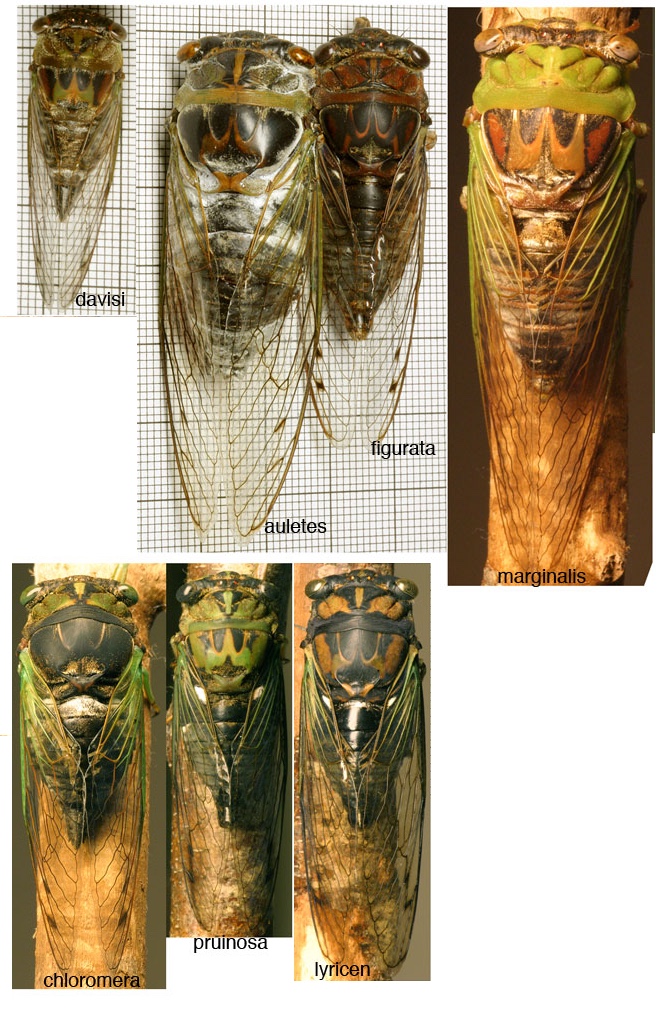
Top row, left to right:
Neotibicen davisi (formerly Tibicen davisi)
Megatibicen grossus (formerly Megatibicen grossus, Tibicen auletes)
Megatibicen figuratus (formerly Tibicen figurata)
Megatibicen pronotalis (formerly Tibicen marginalis)
Bottom row, left to right:
Neotibicen tibicen tibicen (formerly Tibicen chloromera)
Neotibicen pruinosus (formerly Tibicen pruinosa)
Neotibicen lyricen (formerly Tibicen lyricen)

Dusk is the time of day between sunset and night. Many species of Megatibicen & Neotibicen (formerly Tibicen) sing at this time. I’m not sure why they sing at this time — perhaps it helps them avoid audio competition with other singing insects, or perhaps it helps them avoid predators by calling at this specific time of the day.
If you find yourself outdoors in the eastern half of the U.S. after sunset and hear a cicada call, it is likely one of the following Megatibicen or Neotibicen species:
Megatibicen are LARGE and LOUD cicadas.
Megatibicen auletes aka the Northern Dusk Singing Cicada. This cicada can be found in these states: AL, AR, CT, DE, DC, FL, GA, IL, IN, IA, KS, KY, LA, MD, MA, MI, MS, MO, NE, NJ, NY, NC, OH, OK, PA, SC, TN, TX, VA, WV, WI. Season: July to Fall.
M. auletes Call*:
Megatibicen figuratus aka the Fall Southeastern Dusk-singing Cicada. Found in: AL, AR, FL, GA, LA, MS, NC, SC, TN, TX, VA. Season: July to Fall.
M. figuratus Call*:
Megatibicen resh aka Resh Cicada aka Western Dusk Singing Cicada. Found in: AR, KS, LA, MS, NE, OK, SC, TN, TX. Season: July to Fall.
M. resh Call*:
Megatibicen resonans aka Southern Resonant/Great Pine Barrens Cicada aka Southern Dusk Singing Cicada. Found in AL, FL, GA, LA, MS, NC, SC, TN, TX, VA. Season: July to Fall.
M. resonans Call*:
Medium-sized, green cicadas with calls that sound like the rhythmic grinding of a scissor on a sharpening wheel (not a common tool in the 21st century).
Neotibicen pruinosus pruinosus aka Scissor(s) Grinder. Found in AL, AR, CO, IL, IN, IA, KS, KY, LA, MI, MN, MS, MO, NE, OH, OK, SC, SD, TN, TX, VA, WV, WI. Season: June – September. Neotibicen pruinosus fulvus aka Pale Scissor(s) Grinder Cicada. Found in: KS, OK. Season: June – September.
N. pruinosus Call*:
Neotibicen winnemanna aka Eastern Scissor(s) Grinder. Found in AL, DE, DC, GA, KY, LA, MD, MS, NC, NJ, PA, SC, TN, TX, VA, WV. Season: June – Fall.
N. winnemanna Call*:
*Audio files are Copyright of InsectSingers.com. Season information gathered from BugGuide.net.
Paul Krombholz has come through with an awesome guide to identifying Tibicens just after they have molted. Click the image below for an even larger version. Note that the genus of these cicadas has changed to either Megatibicen or Neotibicen — notes below.
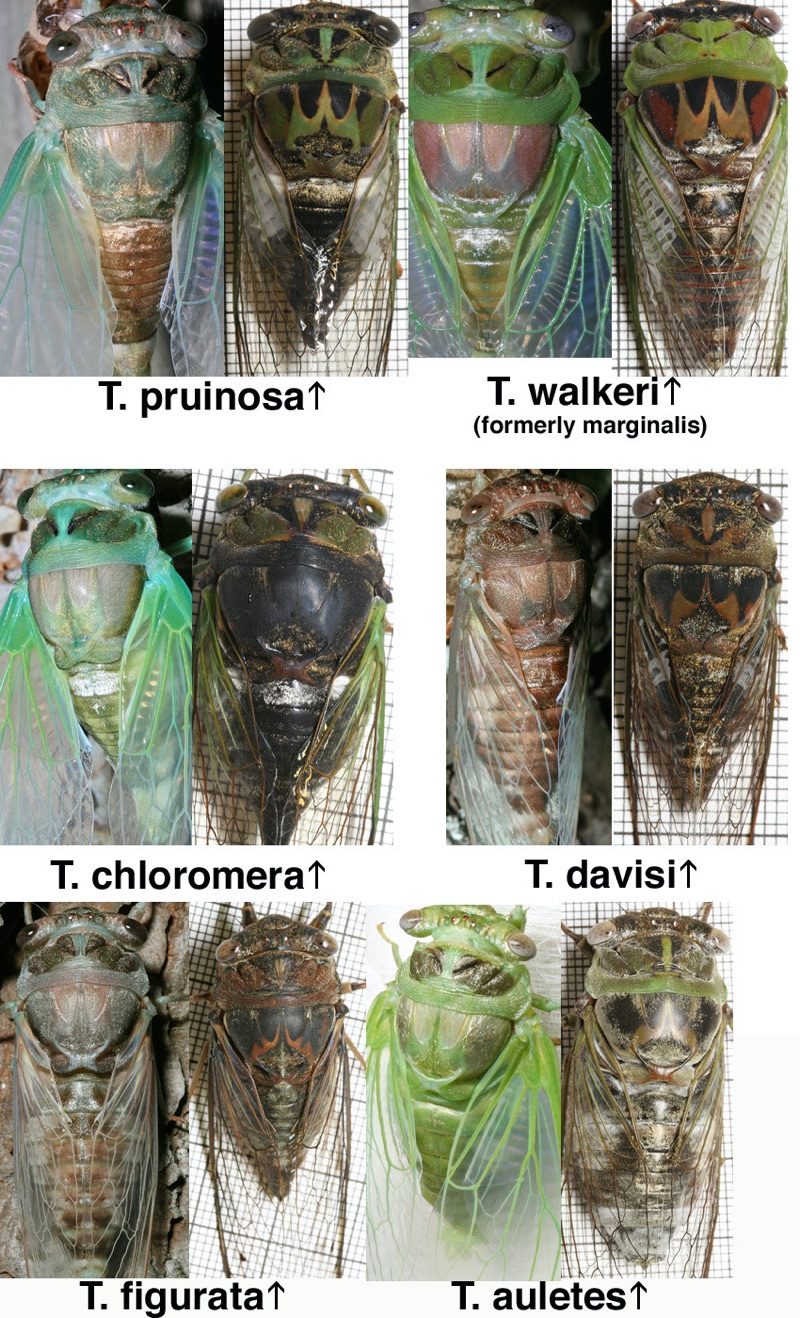
Notes on the species from Paul:
N. pruinosus [formerly T. pruinosa]—Newly molted adult has darker mesonotum (top of mesothorax) than the very common T. chloromera. Abdomen is a golden orange color. Older adult has dark olive on lateral sides of mesonotum, lighter green below the “arches”.
M. pronotalis (formerly walkeri, marginalis)—Quite large. The reddish brown color can be seen on the mesonotum of newly molted adult. Older adult has solid green pronotum (top of prothorax) and red-brown markings on sides of mesonotum. Below the “arches” the mesonotum color can range from carmel to green. Head is black between the eyes.
N. tibicen [T. chloromerus, T. chloromera]—has large, swollen mesonotum, quite pale in a newly molted adult and almost entirely black in an older adult. Individuals from east coast can have large russet patches on sides of mesonotum. The white, lateral :”hip patches” on the anteriormost abdominal segment are always present, but the midline white area seen in my picture is sometimes absent.
N. davisi—Small. This is a variable species, but all have an oversized head that is strongly curved, giving it a ‘hammerhead’ appearance. Newly molted individuals are usually brown with blueish wing veins that will become brown, but some have more green in wing veins. Some may have pale mesonotums that will become mostly black. Older adults vary from brownish to olive to green markings on pronotum and mesonotum.
M. figuratus [formerly T. figurata]—a largish entirely brown cicada. Newly molted adult has a pink-brown coloration with some blueish hints. Older adult has chestnut-brown markings and no green anywhere. The Head is not very wide in relation to the rest of the body. The small cell at the base of the forewing is black.
M. auletes—a large, wide-bodied cicada. The newly molted adult is very green, but the older adult loses most of the green, usually retaining an olive posterior flange of the pronotum. The dorsal abdomen of the adult has a lot of powdery white on the anterior and posterior segments with a darker band in between.
From my own photos, here’s a sequence of photos of a Neotibicen tibicen tibicen as its colors develop.
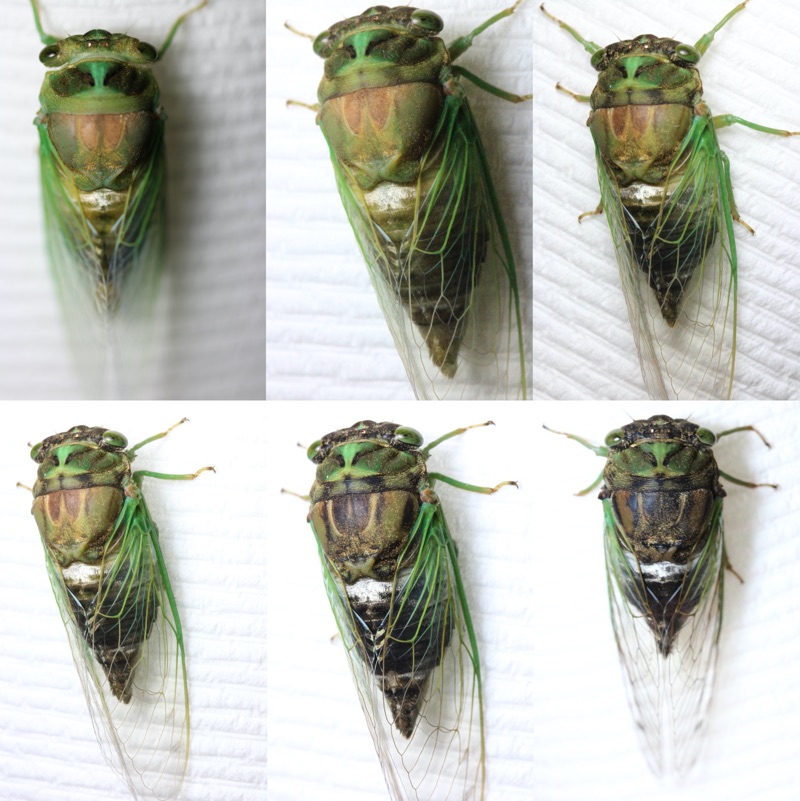
Here’s a comparison of two teneral Neotibicen linnei. Note the variation in colors — one green, one pink — from the same grove of trees in New Jersey. Color can vary a lot!
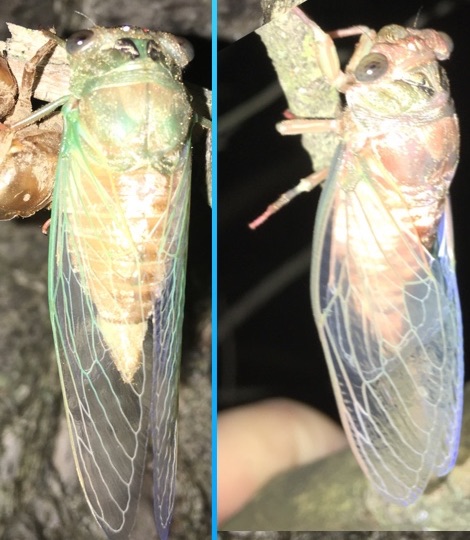
Tibicen season is officially over in central Mississippi. Here’s some great side view photos from Paul Krombholz.
Neotibicen pruinosus pruinosus (Say, 1825):
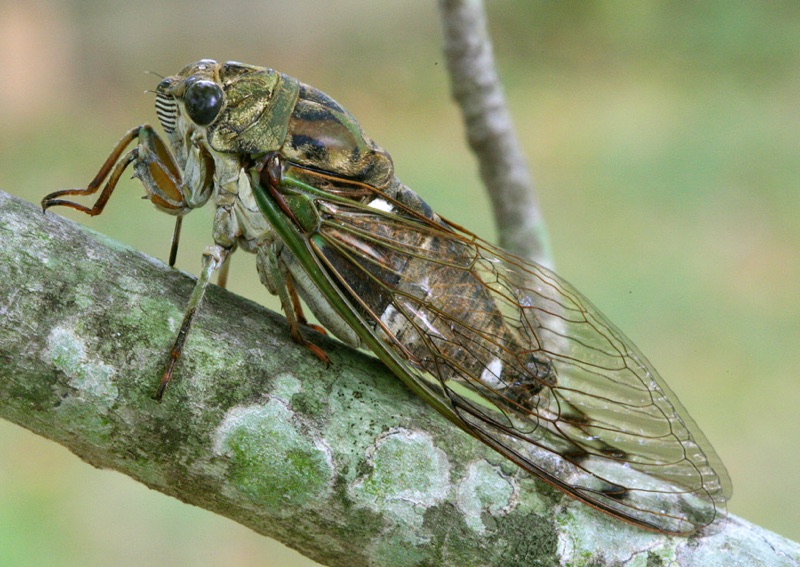
Megatibicen figuratus (Walker, 1858):

Cicada researcher Kathy Hill took this unbelievable photo of 18 different USA Neotibicen & Megatibicen specimens, plus a Quesada gigas (upper right) for comparison.
Click/tap the image for a much larger version. Contact Insect Singers for more information about the image.
I just took a photo of all the “eastern USA” Tibicens except
latifasciata, which we haven’t got yet (I didn’t include the “little
western” Tibicens like T. texana that are more centrally located
either). But I did also add T. duryi from the west coast and Q.
gigas, just for comparison.I just wanted to prove that auletes IS the biggest USA cicada 🙂
Note that the these cicadas were reorganized into two new genera: Megatibicen (larger USA Tibicen) and Neotibicen (smaller USA Tibicen) since this original announcement in 2006.
* Note as of 2023 the name of this cicada has changed to Megatibicen grossus. You can also call it a Northern Dusk-Signing Cicada. Cicada names change a lot.